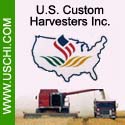 |
 |

|
|
|
Wisconsin Ag News Headlines |
 |
Wisconsin Has a Tool to Combat Disease Endangering Oaks
Wisconsin Ag Connection - 04/02/2024
The Wisconsin Department of Natural Resources has developed a tool to slow the spread of oak wilt, a fungal disease killing thousands of trees each year.
Oaks, a keystone species in Wisconsin, are most susceptible to infection and to spreading the disease when trees or branches have been cut or damaged.
The DNR’s satellite mapping system tells forest owners when it’s the safest time to harvest or prune oak trees. Developed by the DNR and the University of Wisconsin-Madison in 2021, the mapping system is based on temperature and improves the accuracy of advise about maintaining forests as climate change and warm winters decrease predictability.
The tool is designed to be able to respond to the unpredictability of climate change.
Oak wilt is commonly spread when spore-carrying beetles infect damaged trees. By tracking temperature, the tool works by predicting when the beetles will emerge.
“That could be in March, April, May. Last year it was April 15 for the southern part of the state. It was a little later in the north,” said Mike Hillstrom, a forest health specialist with the DNR.
Despite the historic warm weather, the threat to the health of oak trees remains low as April nears.
Oak wilt has been infecting oak trees in Wisconsin since the mid-1940s and the disease is well-established in the southern two-thirds of the state. Just six counties in northern and eastern Wisconsin — Iron, Taylor, Door, Kewaunee, Calumet and Manitowoc Counties — have not detected oak wilt.
Saving the oaks will have enumerable benefits
Oak trees are a critical part of the state’s forest ecosystem. Wisconsin has about 17 million acres of forest. Oak is the second most common hardwood to the maple. The wood is used for products like furniture and flooring. The trees are cover for birds and insects and acorns are an important food source for wildlife.
The National Wildlife Federation identifies oaks as the top keystone plant in the northern forests of the United States — the trees host 445 species of native caterpillars that are in turn critical to the survival of birds and other wildlife.
And the long-lived trees, growing to enormous size over centuries, are simply beautiful.
“Every year, we find a few new townships that have oak wilt in them,” Hillstrom said. “It’s complicated. We can’t reach every pocket. Not everybody is even aware that oak wilt is out there on the landscape. We do our best to educate what it looks like so people are aware of it and can hopefully respond in the best way they can.”
In general, the DNR has suggested for years that people avoid harvesting or pruning oak trees between April 1 and July 15 in the south or April 15 and July 15 in the north. Hillstrom said that’s based on having about a week straight of temperatures in the 60s.
“Every year is a little different. The insects and the fungus don’t know if it’s March, April or May,” Hillstrom said. “It’s a good general guideline to help the public know the time window.”
In the last couple years, the DNR has been using the satellite mapping technology to more precisely determine when foresters can safely harvest oak trees in state-owned forestland.
Click here to read more wpr.org
Other Wisconsin Headlines
|
|
 |


|
 |
|
Copyright © 2024 - Farms.com. All Rights Reserved. |
 |
|